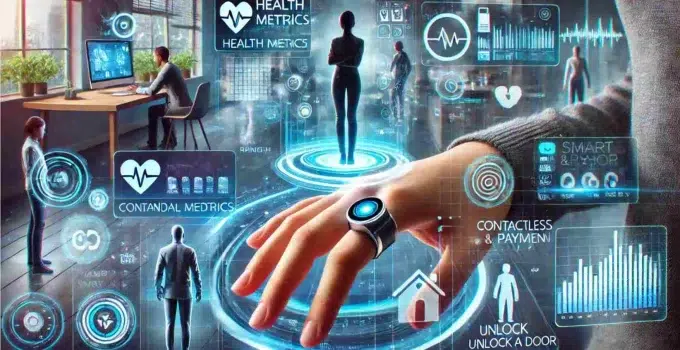Introduction
Technological advances have transformed human interactions worldwide through the invention of wearable devices that integrate advanced functions which is known as smart living.
As part of the future of smart living, modern wearables like smartwatches, fitness trackers, augmented reality (AR) glasses, and smart clothing enhance convenience, productivity, and health monitoring. With the expansion of the Internet of Things (IoT), these innovations are becoming essential, seamlessly connecting humans with digital intelligence to create a more efficient and connected lifestyle.
What Are Tech-Integrated Wearables?
Real-time data automation and connectivity features enable tech-integrated wearables through their integration into accessories and clothing pieces. The devices use modern technology to monitor physical activities together with health metrics while boosting communications and supporting augmented reality capabilities.
Devices empowered by AI sensors and wireless connectivity systems maintain their status as fundamental parts of contemporary digital environments.
Types of Tech-Integrated Wearables
Smartwatches & Fitness Trackers
Smartwatches such as the Apple Watch, Samsung Galaxy Watch, and Fitbits measure heart rate and track body statistics including steps taken and oxygen level monitoring.
Specific watch models provide features that track electrocardiogram readings, measurement of sleep patterns, and assessment of stress levels.
Augmented Reality (AR) & Virtual Reality (VR) Wearables
The leading AR/VR devices include Meta Quest along with Microsoft HoloLens combined with Google Glass which help evolve gaming spaces and provide solutions for remote work while enhancing educational environments.
Users can perform real-time navigation while utilizing hands-free communication and experiencing interactive functions through AR glass technology.
Smart Rings & Smart Jewelry
The Oura Ring provides discretion while measuring heart rate variability together with sleep patterns and activity data in a fashionable design.
The monitoring of stress and wellness integrates with smart necklaces and smart earrings.
Smart Clothing & Textile Wearables
The body temperature along with posture information and hydration level analysis can be tracked by embedded sensors built into shirts shoes and jackets.
Nike together with Under Armour and Hexoskin continue to develop apparel products that provide biofeedback monitoring capabilities.
Wearable Medical Devices
Diabetic patients who use Freestyle Libre among other continuous glucose monitors (CGMs) achieve real-time monitoring of their blood sugar levels.
Through their combination of smart hearing capabilities and brainwave-tracking headbands, these devices provide users with better cognitive performance while helping them monitor their mental status.
Key Benefits of Tech-Integrated Wearables
Health & Fitness Optimization
Wearables enable users to see their heart rate data alongside blood pressure measurements and activity levels in real-time.
Wearable technology guides users toward fitness success through personal monitoring in combination with artificial intelligence recommendations.
Enhanced Productivity & Convenience
Smartwatches provide notifications through their interface, enabling users to deliver voice commands while maintaining an optimized connection between several devices.
People using hands-free navigation, note-taking, and communication features will experience better work productivity.
Safety & Security
Wearing devices with GPS tracking functions provide essential location monitoring capabilities that benefit both senior citizens elders and kids and those who enjoy outdoor activities.
An additional layer of personal safety comes through devices that detect falls trigger SOS alerts and provide biometric verification systems.
Augmented Reality & Immersive Experiences
Augmented reality (AR) glasses use interactive features to reimagine gaming experiences as well as provide virtual assistance for remote work and improve shopping and travel activities.
Training simulations built through virtual reality wearables enable medical programs at military installations alongside additional educational facilities.
Medical Advancements & Chronic Disease Management
Wearable devices let doctors track patients from a remote location by monitoring diseases such as diabetes hypertension and sleep apnea.
Medical alert systems powered by artificial intelligence detect upcoming health threats which result in the prevention of emergencies.
Challenges & Future of Wearables
Wearable devices that integrate technology exhibit limitations in data privacy as well as power management and security of stored information. The combination of biodegradable sensor innovations together with AI analytics and fifth-generation network advancements will intensify their operational capabilities.
Future wearables will merge with smart homes AI assistants and brain-machine interfaces to become essential components for people who embrace technological living.
Conclusion
Revolutionary tech-integrated wearables redefine our daily existence by delivering health monitoring alongside communications improvements coupled with security systems along immersive features. The prognosis indicates future devices will strengthen their capabilities while becoming smaller in size and achieving better network integration. Investing in wearables serves as a smart and healthy gateway toward a linked future.






